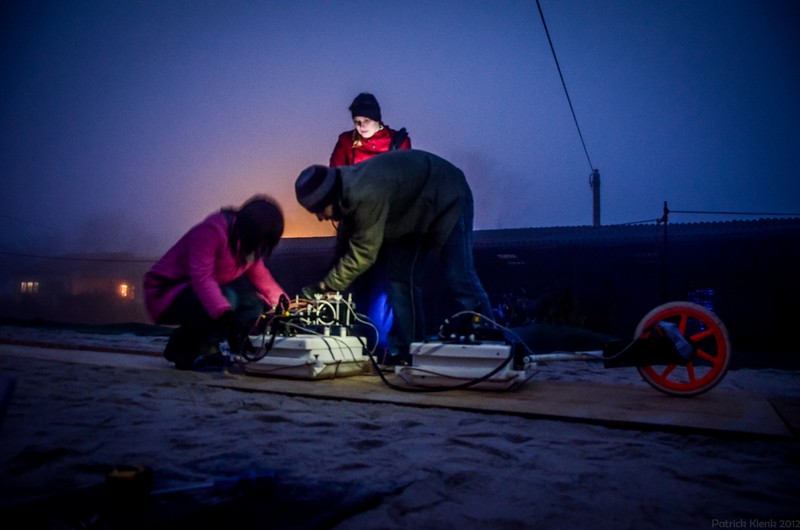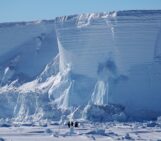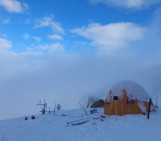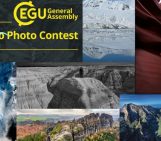We’ve all been there: long hours in the field, a task that seems never ending but which has to be finished today. This week’s Imaggeo on Mondays image is brought to you by Patrick Klenk who highlights the importance of how ‘getting the job done’ relies on good team work!
Two years ago I posted this picture to imaggeo as a tribute to everyone who ever experienced the perils and pitfalls of outdoor field experiments and especially to the colleagues who help you to pull through in the end. It is their scientific spirit which allows to add that indispensable calibration measurement making the difference between a heap of nice-to-look-at data and a quantifiable dataset — even if this means staying on for that extra hour in quickly fading daylight while the cold of a late autumn night encroaches already relentlessly upon your exposed field site.
In this particular case, we started out on a bright late autumn day, planning to quickly complete a week-long series of Ground-Penetrating Radar (GPR) experiments on our ASSESS test site in the vicinity of Heidelberg, Germany. Most certainly, we intended to be finished long before this picture was taken — but alas, as most environmental scientists who are concerned with experimental field studies can probably relate to, outdoor experiments often do not work out exactly as planned and especially timetables get overturned more often than not. In the end, this field day turned out to be the last usable field day for that season and only through the final team effort pictured here we were able to successfully complete a quite involved series of GPR experiments.
The aim of these GPR experiments is to quantify near-surface soil hydraulic properties through the observation of soil water dynamics with non-invasive measurement methods directly at the field scale. To date, the quantification of soil hydraulic properties remain the holy grail of soil sciences, since they are difficult to determine but widely required for a range of applications such as precision agriculture or the prediction of contaminant flow through the subsurface. Traditional approaches, which determine soil hydraulic properties e.g. from soil samples in the laboratory, suffer from their high cost, their destructive nature and from issues of transferability of the results back to the field. We specifically designed our test-site with a complicated but known subsurface structure to allow for the development of quantitative, high-resolution observations of soil water dynamics with GPR. In brief, our approach compares GPR observations of soil water dynamics related processes such as: water sprinkling from above the surface (infiltration) or a varying water table depth (achieved by pumping water in and out of the structure from below: imbibition and drainage) to numerical simulations of both subsurface water flow and the expected GPR response. Our research then focuses (i) on observation based estimation methods of the parameters which are needed by the models we use to calculate physical property distributions (inversion) and (ii) on data assimilation methods (i.e. a form of continuously integrating modelled states of a physical system with available observational data) to optimally combine all available information for quantifying the soil properties in question.
Patrick is a physicist, currently working as a postdoc with the soil physics group at the Institute of Environmental Physics, Heidelberg University, Germany, on novel approaches for developing Ground-Penetrating radar for quantitative soil hydrology.
By Patrick Klenk, postdoctoral researcher at the Institute of Environmental Physics, Heidelberg University, Germany
References
Buchner, J.S., Wollschläger U., Roth K. (2012), Inverting surface GPR data using FDTD simulation and automatic detection of reflections to estimate subsurface water content and geometry, Geophysics, 77, H45-H55, doi:10.1190/geo2011-0467.1.
Dagenbach, A., J. S. Buchner, P. Klenk, and K. Roth (2013), Identifying a soil hydraulic parameterisation from on-ground GPR time lapse measurements of a pumping experiment, Hydrol. Earth Syst. Sci., 17(2), 611–618,doi:10.5194/hess-17-611-2013.
Klenk, P., Jaumann, S., and Roth, K. (2014): Current limits for high precision GPR measurements, in ‘Proc. 15th International Conference on Ground Penetrating Radar (GPR2014), 30 June-04 July 2014, Brussels, Belgium, available online shortly.
Klenk, Patrick, Developing Ground-Penetrating Radar for Quantitative Soil Hydrology, PhD-Thesis, Heidelberg University, 2012, http://www.ub.uni-heidelberg.de/archiv/14329.
Imaggeo is the EGU’s open access geosciences image repository. Photos uploaded to Imaggeo can be used by scientists, the press and the public provided the original author is credited. Photographers also retain full rights of use, as Imaggeo images are licensed and distributed by the EGU under a Creative Commons licence. You can submit your photos here.





